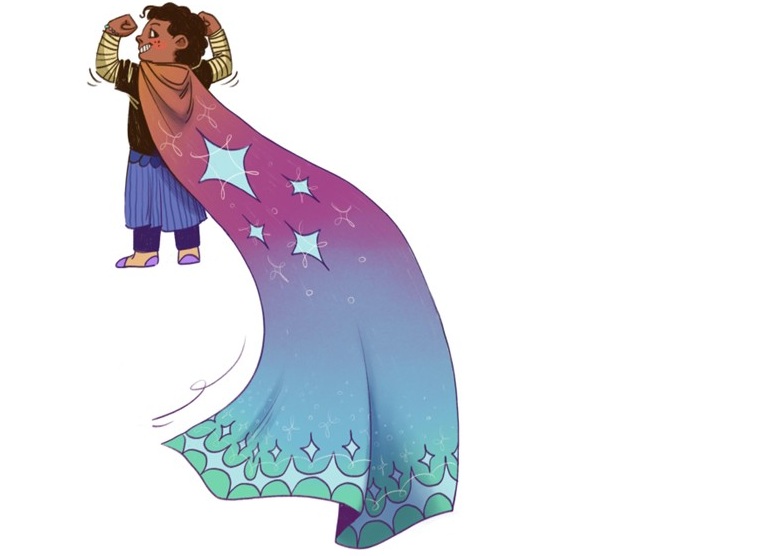Seen and Heard: Creative Journeys into Children's Rights
Katarzyna Salejko

Imagine a classroom wall where a great listening tree spreads its branches, waiting to catch the whispers of children’s voices. Its leaves are covered with poems, questions, and bold declarations: It’s not fair. It’s not right. Nearby, a cloak shimmers with colours and words of kindness, stitched together from moments when empathy was shown. These are not just decorations – they are symbols of superpowers children already hold: empathy, imagination, and the courage to speak out.
If you listen closely, you can almost hear the voices carried on the wind between the tree’s branches: stories of fairness, dreams of freedom, and songs of welcome. In every classroom where these resources are used, the tree grows taller, the cloak shines brighter, and the children’s voices grow stronger. What begins as a simple piece of paper or a colourful drawing becomes something much greater – a shared spell of human rights and solidarity.
This is the spirit of Seen and Heard: Creative Journeys into Children’s Rights – a new series of educational resources written by award-winning author Sita Brahmachari and beautifully illustrated by Agata Kwiatkowska. Created for children aged 10–14, they bring human rights to life through creativity, storytelling and play.
How the materials were created
These materials were not written for children, but with them. Sita Brahmachari worked closely with young people and educators from Poland, Germany and Malta – including children with refugee and migrant backgrounds – listening to what matters most to them: what makes them feel seen or invisible, what kind of world they want to grow up in.
The conversations, drawings and ideas of those children shaped everything – the tone, the exercises, even the rhythm of the lessons. This co-creation process lies at the heart of the project: education with children, not about children. It reflects the core values of participation, empathy and voice that the materials themselves seek to nurture.
Each pack follows a clear but flexible structure. It begins with gentle activities that spark curiosity, build trust and create emotional safety. Step by step, it moves into creative projects – art, writing, drama, music – where students explore what rights mean in their own lives. Reflection prompts connect feelings to rights, helping children make sense of what they’ve created. Finally, every journey ends with ideas for community engagement – small, real actions that take learning beyond classroom walls.
This flexible design makes the series a toolkit, not a prescription. Teachers and youth workers can choose, adapt and grow with it, shaping the journey to fit their group’s interests and needs.
Educational and methodological approach
At their core, the Creative Journeys into Children’s Rights materials are rooted in values-based learning – understanding rights not as distant theory but as a daily practice of empathy and respect. They promote experiential learning, encouraging children to learn by doing, expressing and feeling.
Methodologically, the resources draw on creative pedagogy, inquiry-based learning and community-based approaches. Children are invited to ask questions, imagine new possibilities and see themselves as agents of change – in their class, in their town, and in the wider world.
Each journey begins where children already are: in their own emotions and experiences. From there it expands outward – first to the classroom community, then to families, and finally to the global landscape of human rights. The change begins close to home and grows through empathy and imagination.
Emotional safety is at the centre of this learning. Every child’s voice matters; listening is as important as speaking.
And so the role of the teacher changes too. In this approach, the teacher is not a lecturer standing apart but a facilitator, a guide, a companion on the journey – someone who helps connect imagination to the language of rights. It is about inviting discovery, not delivering content. And in doing so, teachers often rediscover something themselves: the joy and hope that come from seeing children find their voices.
The three resources published so far
The series will eventually include five booklets. The first three are now ready and free to download:
- Hear Me, See Me: A Creative Introduction to Children’s Rights – introducing the UN Convention on the Rights of the Child through the magical Human Rights Tree, playful games, and creative storytelling.
- In Our Hands: Exploring Freedom of Expression Through Creative Action in Our Communities – inviting young people to raise their voices, write for change, and create Hands of Change that show the world they want to build.
- The Power of Empathy: Standing Up for Refugee and Migrant Rights – encouraging students to step into others’ shoes, craft an Empathy Cloak, and reflect on how words, stories and actions shape the lives of those seeking safety.
Explore and download the resources here
